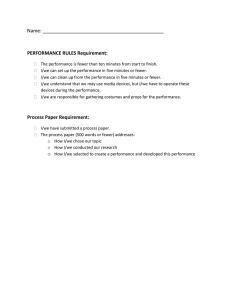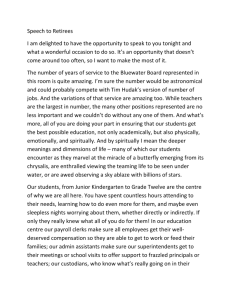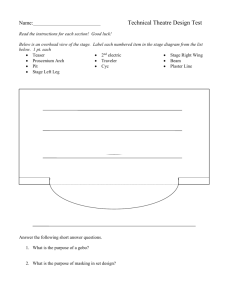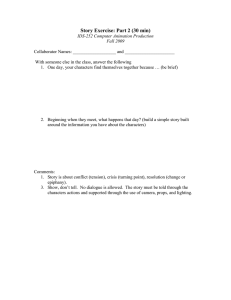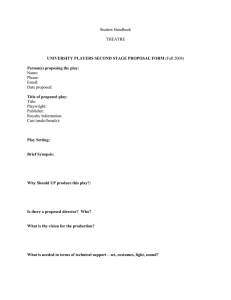Safety in Dramatic Arts Programs - Bluewater District School Board
advertisement
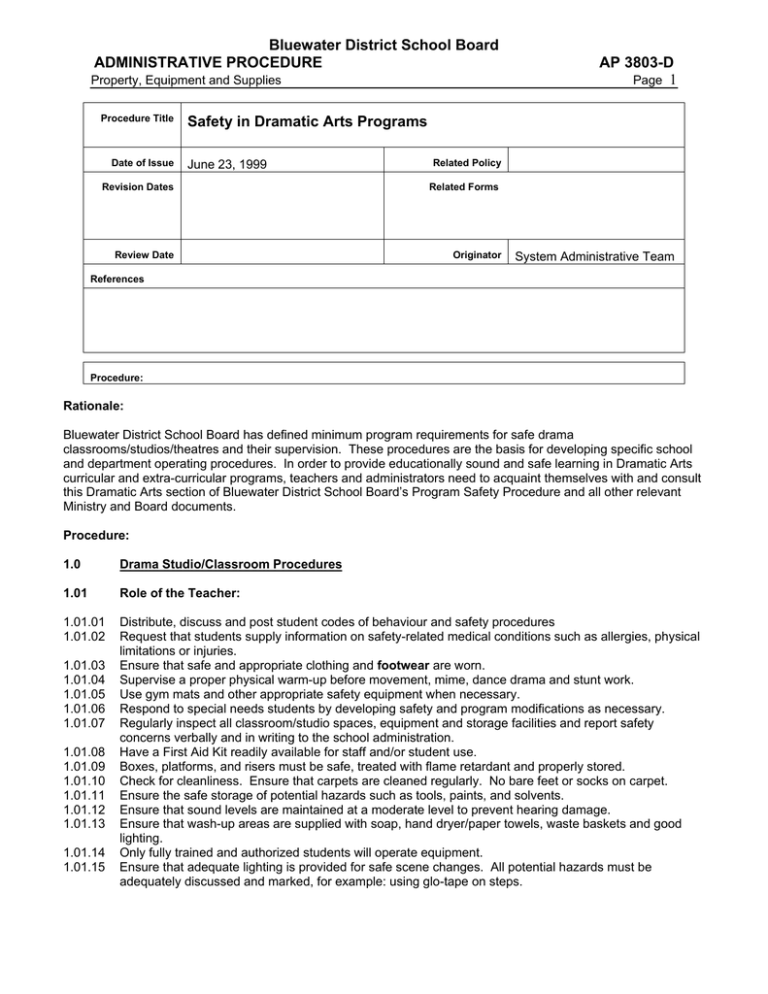
Bluewater District School Board ADMINISTRATIVE PROCEDURE Property, Equipment and Supplies Procedure Title Date of Issue AP 3803-D Page 1 Safety in Dramatic Arts Programs June 23, 1999 Related Policy Revision Dates Related Forms Review Date Originator System Administrative Team References Procedure: Rationale: Bluewater District School Board has defined minimum program requirements for safe drama classrooms/studios/theatres and their supervision. These procedures are the basis for developing specific school and department operating procedures. In order to provide educationally sound and safe learning in Dramatic Arts curricular and extra-curricular programs, teachers and administrators need to acquaint themselves with and consult this Dramatic Arts section of Bluewater District School Board’s Program Safety Procedure and all other relevant Ministry and Board documents. Procedure: 1.0 Drama Studio/Classroom Procedures 1.01 Role of the Teacher: 1.01.01 1.01.02 Distribute, discuss and post student codes of behaviour and safety procedures Request that students supply information on safety-related medical conditions such as allergies, physical limitations or injuries. Ensure that safe and appropriate clothing and footwear are worn. Supervise a proper physical warm-up before movement, mime, dance drama and stunt work. Use gym mats and other appropriate safety equipment when necessary. Respond to special needs students by developing safety and program modifications as necessary. Regularly inspect all classroom/studio spaces, equipment and storage facilities and report safety concerns verbally and in writing to the school administration. Have a First Aid Kit readily available for staff and/or student use. Boxes, platforms, and risers must be safe, treated with flame retardant and properly stored. Check for cleanliness. Ensure that carpets are cleaned regularly. No bare feet or socks on carpet. Ensure the safe storage of potential hazards such as tools, paints, and solvents. Ensure that sound levels are maintained at a moderate level to prevent hearing damage. Ensure that wash-up areas are supplied with soap, hand dryer/paper towels, waste baskets and good lighting. Only fully trained and authorized students will operate equipment. Ensure that adequate lighting is provided for safe scene changes. All potential hazards must be adequately discussed and marked, for example: using glo-tape on steps. 1.01.03 1.01.04 1.01.05 1.01.06 1.01.07 1.01.08 1.01.09 1.01.10 1.01.11 1.01.12 1.01.13 1.01.14 1.01.15 Bluewater District School Board ADMINISTRATIVE PROCEDURE Property, Equipment and Supplies AP 3803-D Page 2 1.01.16 Any alterations to stage or classroom facilities and equipment must comply with the Building, Fire or Electrical Codes. 1.02 Role of the Student: 1.02.01 Adhere to the Board’s school and drama department procedures for behaviour and safety, as distributed, discussed and posted. Students must avoid horseplay and any behaviour deemed inappropriate and unsafe by a supervising teacher. Students shall be requested to inform teachers of medical information which may affect the safety and well-being of themselves and others. Teachers must also be informed of limitations which would impede participation in any activity, so that modifications can be made. Students must use and/or wear all personal protective equipment as instructed by the teacher. 1.02.02 1.02.03 SAFETY RESOURCES REFERENCES Books: McCann, Michael, Health Hazards Manual for Artists. New York: Lyons & Burford, Publishers, 1985. Safety Guidelines for the Live Performance Industry in Ontario. Queen’s Printer for Ontario, January 1997. Rossol, Monona, Stage Fright: Health and Safety in the Theatre. New York: Allworth Press, 1991. Winter, Ruth, Cosmetic Ingredients. New York: Crown Publishers, Inc., 1989. Periodicals: “Final Version of NIOSH Fog Report Ready” Acts Facts, Vol. 9 No. 7, July 1995 “Smoke Study Under Fire” Acts Facts, Vol. 9, No. 11, Nov. 1995 “Asthma After Exposure to Theatrical Fog” Acts Facts, Vol. 10, No. 4, April 1996 “Kohl Eye Makeup is a Source of Lead Poisoning” Acts Facts, Vol. 10, No. 5, May 1996 “Survey of Actor/Dancer Injuries” Acts Facts, Vol. 10, No. 3, March 1996 “Look Out Behind You!” Art Hazard News, Vol. 16, No. 5, 1993 “Arts-Related Exposure to OPIM” Art Hazard News, Vol. 16, No. 4, 1993 “Brandon Lee Killed: Firearms Safety” Art Hazard News, Vol. 16, No. 2, 1993 Babin, Angela, “Fire Retardants for the Theatre” Art Hazard News, Vol. 20, No. 2, 1997 Corti, Dan, “Removal of Asbestos-Covered Theatre Light Cords”, Art Hazard News, Vol. 19, No. 1, 1996 McCann, Michael, “Fog and Smoke”, Art Hazard News, Vol. 13, No. 10, 1990 McCann, Michael, “Pyrotechnics and Explosive Effects”, Art Hazard News, Vol.18, No. 5, 1995 Videos: “Play it Safe - Introduction to Theatre Safety” “Scaffolding and Ladder Safety” Bluewater District School Board ADMINISTRATIVE PROCEDURE Property, Equipment and Supplies AP 3803-D Page 3 APPENDIX A 2.0 Extra-curricular and Production Procedures A school production may require extraordinary theatre elements beyond the scope of what generally happens in the drama class. To minimize risk, additional preparations and procedures need to be developed and followed. A general framework for these preparations and procedures includes, but is not limited to, creating and adhering to: a) clear and specific job descriptions, b) clear channels of communication, to facilitate the reporting on and updating of status reports on equipment, procedures and personnel, and c) clear “Permission to Abort” and Emergency procedures 2.01 Role of the Administrator: 2.01.01 2.01.02 2.01.03 Ensure that all applicable safety criteria have been identified and incorporated into the production plan. Review and approve the production plan and budget. Monitor the progress of the production against the plan. 2.02 Role of the Teacher: 2.02.01 Teachers should have access to, and be familiar with, Safety Guidelines for Live Performance Industry in Ontario, 2nd edition, January 1997. This document is available in each school and through the Safety Office. 2.02.02 Teachers must be aware of and comply with Administrative Procedures of Bluewater District School Board. 2.02.03 Teachers must review the school’s emergency plan and be prepared to implement it if required. Teachers must ensure the plan addresses all extra-curricular situations. Emergency Evacuation and Fire Safety Plans are available at each location. 2.02.04 Teachers shall ensure that each participant has completed a Student Health Information and Consent to Release Form (AF 6813), which includes a) permission to obtain medical treatment, signed by a parent/guardian if the participant is under the age of majority, b) his/her parents’/guardians’ telephone numbers, and c) his/her personal physician’s name and telephone number. 2.02.05 Teachers are to ensure that a written production plan is developed and approved by the School Principal that includes: a) budget b) timings c) emergency procedures d) job description e) special effects f) weapons, etc. 2.02.06 Teachers are to ensure that all rehearsals, production work, and related activities are directly and effectively supervised. 2. 02.07 Teachers must communicate and thoroughly discuss safety regulations, expectations, responsibilities and potential hazards with participating students. Teachers must ensure all production crews, staff and students are trained or in the process of being trained. 2.02.08 Teachers must regularly inspect all theatre/rehearsal spaces, equipment, and storage facilities and report any safety concerns verbally and in writing to the school administration or School Safety Committee. 2.02.09 Teachers must minimize risk to the audience and encourage participant safety, such as keeping all fire exits clear at all times. 2.02.10 A first aid kit must be accessible for staff and student use in the theatre or rehearsal space or in an accessible designated area. 2.02.11 Teachers must complete and submit accident reports for all injuries sustained by staff and/or students. 2.02.12 All staff should practice Universal Precautions and maintain good personal hygiene to reduce the risk of contracting or transmitting any communicable disease. 2.02.13 Teachers must ensure that students wear and/or use all personal protective equipment as instructed by the teacher. Bluewater District School Board ADMINISTRATIVE PROCEDURE Property, Equipment and Supplies AP 3803-D Page 4 2.03 Role of the Student: 2.03.01 2.03.02 2.03.03 Students must follow safety and behaviour procedures as defined by the teacher. Students must avoid horseplay and any behaviour deemed inappropriate by the supervising staff. Students must be requested to inform teachers of medical information which may affect the safety and well-being of themselves and/or others. Teachers should also be informed of limitations which would impede participation in an activity, so that suitable modifications can be made. Students must use and/or wear all personal protective equipment as instructed by the teacher. Bluewater District School Board ADMINISTRATIVE PROCEDURE Property, Equipment and Supplies AP 3803-D Page 5 APPENDIX B 3.0 Make Up 3.0.01 Read all labels and adhere to all manufacturers’ instructions. Only use products for which instructions and advisories are available. 3.0.02 Use only cosmetic products on the skin. Never use paints, dyes, or other non-cosmetic substances. 3.0.03 Wash hands before and after applying make-up. Those applying make-up should wash their hands before they start on each client, and they should wash or discard sponges and brushes after using them on each client. 3.0.04 Never lend make-up to anyone; never borrow or accept used make-up from anyone. 3.0.05 Moisten brushes or pencils with clean tap water, not with saliva. 3.0 06 Replace old cosmetics regularly. 3.0.07 Do not use aerosols in small, poorly ventilated rooms. 3.0.08 Avoid creating clouds of face powder or talcum powder that can be inhaled. Discard old face and bath powders. 3.0.09 Instruct participants to seek medical advice about, and treatment for, eye injuries, dermatitis, acne, and other skin and eye conditions. 3.0.10 Do not eat or drink when using make-up. Bluewater District School Board ADMINISTRATIVE PROCEDURE Property, Equipment and Supplies AP 3803-D Page 6 APPENDIX C 4.0 Hand Props and Costumes 4.0.01 The safety of performers and others who handle props and costumes should be taken into account in all stages of the design, purchase, construction, repair, maintenance and use of props and costumes. Consideration should be given to the safe integration of hand props and costumes with the other elements of the production, including but not limited to scenery, lighting, sound and performance venues. 4.0.02 All aspects of costumes should be designed and constructed to avoid injury or unnecessary discomfort. Costumes, including masks, wigs and headgear, should: a) provide a field of vision adequate for safe movement on and off stage, b) not obstruct the performer’s breathing or hearing, c) be fitted and balanced to prevent headaches, neck or back strain. 4.0.03 Props and costumes should be checked regularly for wear or damage and repaired or replaced when necessary. Store props and costumes in areas free of solvent fumes and safely away from heat sources. 4.0.04 Performers should inform the person(s) responsible as soon as possible of any repairs needed to maintain the safety of a costume or prop. Props should be checked for rough edges, chips, loose material or other potential hazards before being given to the performers. 4.0.05 Performers should be given adequate instruction and rehearsal time to become accustomed to all props and costumes as they are to be used in performance, including scene changes and costume quick changes. 4.0.06 Performers should inform the company as soon as possible about any allergies or adverse physical reactions to props and costume materials. 4.0.07 Those portions of props or costumes which are likely to come in contact with the performer should be free of materials or finishes which could cause injury or harm. 4.0.08 Paints, dyes, adhesives, and solvents used in construction, repair and maintenance should be allowed to evaporate completely, in a well ventilated space, before the costume or prop is used. Paints and other solvents should be stored in approved locations. 4.0.09 Alternatives to open flame should be considered wherever possible. Where an open flame is used, items placed or used near open flame should be made of fire resistant materials or treated with flame retardant. 4.0.10 Gypsona masks should not be made directly on the skin. Use a protective barrier between the skin and uncured gypsona. Bluewater District School Board ADMINISTRATIVE PROCEDURE Property, Equipment and Supplies AP 3803-D Page 7 APPENDIX D 5.0 Stage Lighting: 5.0.01 Student Lighting Crews should operate under clear, specific and appropriate Health and Safety Stage Lighting Crew rules. 5.0.02 Each staff member, student or contract worker should know and abide by the responsibilities and limits of his/her job. Each staff member, student or contract worker, should be instructed to be on the lookout for and report any real or suspected dangerous equipment, situations or behaviour. Attentiveness and discipline are keys to working safely. This includes, but is not limited to: a) erecting/dismantling and using ladders, scaffolds, lifts and catwalks, b) hanging, focusing, securing and “safety-chaining” lighting instruments and accessories, c) connecting, re-lamping, and repairing instruments, d) “patching”, and selecting, running and securing appropriate temporary extension cable, e) operating the control console and/or patch panel and/or follow spots. 5.0.03 No hard wiring is permitted except by a qualified electrician: electrical equipment shall be connected to the electrical power source by means of a plug connector. 5.0.04 Establish and use clear chains of command and standardized verbal and other communication codes when installing, running and striking theatre lighting equipment. 5.0.05 No other activity should take place on stage or in the house when theatre lights are being hung, focused or repaired in position. 5.0.06 No unauthorized or unplanned work shall be undertaken. 5.0.07 No lighting or other electrical instrument or equipment shall be used without first guaranteeing its safety and compliance with appropriate electrical Codes of CSA/UL Standards. Things to be on guard for include, but are not limited to: a) over-lamped or incorrectly lamped instruments (bulbs with the wrong profile, or wattage in excess of the manufacturer’s instructions). b) units with cracked lenses, missing safety chains, or physical damage, c) suspect wiring or electrical connectors, and cable too narrow in gauge (lighting extension cable is 14/3 SJ cable; 12/3 is recommended for many applications), and d) incorrectly run, suspended or stored electric cable. Bluewater District School Board ADMINISTRATIVE PROCEDURE Property, Equipment and Supplies AP 3803-D Page 8 APPENDIX E 6.0 Sound and Sound Systems: 6.0.01 Electric circuits are easily overloaded when numerous pieces of sound equipment are connected, theatre sound systems typically draw much more power than home systems. The supervisor should ascertain that no electrical or physical hazards exist in the setting up, running and striking of sound systems. 6.0.02 Liquids shall not be permitted around electrical equipment or sound systems. 6.0.03 Only trained and authorized staff, students or contract workers shall set up, operate and strike sound systems. 6.0.04 Sound systems should be set up and operated to guarantee the physical and auditory safety of all audience, performers and show crews. Sound cue level should be set, recorded and adhered to for all performances. Decibel meters should be used to determine maximum allowable sound intensity (to a maximum 85 decibels continuous sound, 100 decibels impulse sound intensity). Sound sources located above, behind or to the side of the listener are less than those directly in front. Bluewater District School Board ADMINISTRATIVE PROCEDURE Property, Equipment and Supplies AP 3803-D Page 9 APPENDIX F 7.0 Lifts, Ladders and Scaffolds: 7.0.01 Training is required before using lifts, ladders and scaffolds. View Ladder Safety, a video, and/or any print instructions and advisories provided by the manufacturer of any such equipment, or the Board, prior to use. The Principal will be able to provide an up-to-date list of trained staff,who will be able to provide training. 7.0.02 Different ladder types and lengths dictate different safe operating procedures. Staff, students and contract workers shall follow the manufacturer’s instructions. Use only ladders intended for the type of work being undertaken. 7.0.03 Erectable scaffolds shall include all platforms, cross bracing, outriggers, guardrails and fittings required by the manufacturer and the Occupational Health and Safety Act and Regulations. 7.0.04 Electric or hydraulic personnel lifts shall be operated according to the manufacturer’s instructions; and at no time shall be allowed to exceed the maximum weight. Outriggers shall be used at all times. 7.0.05 Unnecessary items (pocket contents, etc.) should not be taken aloft. All tools should be tethered to a suitable anchor when used aloft so that they cannot fall to the ground. Bluewater District School Board ADMINISTRATIVE PROCEDURE Property, Equipment and Supplies AP 3803-D Page 10 APPENDIX G 8.0 Stage Sets and Equipment: 8.0.01 Clear chains of command and construction and electrical standards shall be followed to ensure safe and effective stage crew work. 8.0.02 Design, construction, erection, use and striking of stage sets and equipment should be undertaken only by competent supervisors and students. A competent person should be held responsible for the design safety factors when sets must support the weight of a person(s). 8.0.03 All cast and crew must be the beneficiaries of demonstrations of, and rehearsals with, all stage sets and equipment such as fog machines, prior to a performance. 8.0.04 Materials selected for stage sets shall be suitable for interior use, and shall be fire resistant or treated with a flame retardant. 8.0.05 Fire exits shall be kept clear of obstructions at all times. Fire Exit signs must be visible at all times. 8.0.06 All staff, students and contract workers should be made aware of the need to keep all work and performance areas clean, neat and hazard-free. The removal, replacing and storage of properties, set pieces and other items, especially backstage, should be carefully choreographed and rehearsed. 8.0.07 Appropriate clothes and safety equipment shall be required during the construction, installation and striking of sets. 8.0.08 Staff and students should know and abide by a clear set of Health and Safety Stage Crew Rules, tailored to meet the unique demands of the performance space. Bluewater District School Board ADMINISTRATIVE PROCEDURE Property, Equipment and Supplies AP 3803-D Page 11 APPENDIX H 9.0 Special Effects: 9.0.01 Read and abide by all labels and instructions provided by the manufacturers of the special equipment, and follow prescribed techniques used to generate different special effects. 9.0.02 The use of strobe lights, high “impulse” noises (gunshots, etc.) “fog machines” and other equipment that could conceivably trigger adverse reactions must be noted in show programs and “at the door”. 9.0.03 Pyrotechnics should be avoided. Pyrotechnics if being used, shall be under the control of a pyrotechnician who has a clear understanding and working knowledge of the guidelines of the NFPA Code 1126 and of the Department of Energy, Mines and Resources Explosives Division. 9.0.04 Special effect crews shall be fully trained in all aspects of the effect and equipment. Only those crews should be allowed to set-up, operate or strike the equipment. 9.0.05 Generate the special effect exactly as developed in rehearsal every time, without exception. Crews running any special effect who detect anything not as it should be - equipment, position of performers, operators, etc. - should abort and report! Bluewater District School Board ADMINISTRATIVE PROCEDURE Property, Equipment and Supplies AP 3803-D Page 12 APPENDIX I 10.0 Stage Rigging and Flown Scenery, Fall Arrest Systems: Rigging involves all activities involved in prepared theatrical equipment when it is taken to a stage. Rigging equipment includes all the hardware that is used to fly theatrical equipment. Rigging systems are the methods used to raise and lower theatrical equipment vertically by means of blocks and ropes or steel cables. 10.0.01 Bluewater District School Board, as owner, shall be responsible for ensuring that the proper equipment is used for stage rigging and that it is designed and maintained within the design safety factor. Bluewater District School Board shall cause an inspection to be made of the rigging system at least once every three years and a permanent record of the inspection shall be kept. 10.0.02 Where a part of a rigging system is replaced for any reason, the replacement part shall be at least equivalent to the original part as supplied by the manufacturer or as specified in the design submission. 10.0.03 The staff, student or contract worker operating the rigging system shall have such knowledge of and experience in operating the system that, • • the operator is able to operate the rigging system safely the operator is aware of all likely hazards in using the rigging equipment 10.0.04 Temporary flown scenery shall have all ropes, chains, bolts, clamps and other elements of a flown unit of appropriate size and strength for the load that they will bear. 10.0.05 The minimum strength to load ration for the devices for the adjustment of the trim of a flown unit should be secured in position. 10.0.06 Turn-buckles, trim chains and other devices for the adjustment of the trim of a flown unit should be secured in position. 10.0.07 Any ropes, chains or other lines on which scenery is flown should be safety terminated and secured. 10.0.08 Where fall protection is required, fall arrest practices must follow the procedures specified in the Occupational Health and Safety Act, Regulations for Construction Projects, Industrial Establishments, and Window Cleaners. When the potential fall is 10’ or greater, a full body harness, with shock absorbing lanyard and appropriate secure tie-off, is required. Contact the Safety Officer for any assistance.
